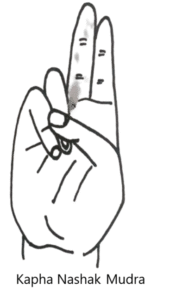Kapha Naashak Mudra
Introduction
In Ayurveda and yogic mudra therapy, the body is governed by three doshas—Vata, Pitta, and Kapha. Imbalance in these doshas leads to physical or mental disturbances. The Kapha Naashak Mudra is a therapeutic hand gesture designed to reduce Kapha dosha (the water–earth principle). It is particularly effective when Kapha is aggravated, manifesting as congestion, lethargy, obesity, cold-related ailments, and excessive sleep.
Meaning
Kapha = combination of water + earth (stability, lubrication, immunity, structure).
Naashak = destroyer or reducer.
Thus, Kapha Naashak Mudra literally means the gesture that reduces or eliminates Kapha energy in the body and mind.
How to Perform (Method of Practice)
Step-by-Step:
Sit in a comfortable meditative posture like Sukhasana, Padmasana, or Vajrasana.
Keep your back straight and shoulders relaxed.
Fold the little finger (water element) and ring finger (earth element) to touch the base of the thumb.
Press these two fingers lightly with the thumb.
Keep the index and middle fingers extended outward.
Rest hands on the knees, palms facing upward.
Close your eyes, focus on your breath, and practice slow, deep inhalation and exhalation.
Benefits
Physical Benefits
Reduces Kapha-related disorders: cough, cold, congestion, sinusitis, asthma, excess mucus.
Helps in weight reduction by improving metabolism.
Improves digestion and relieves sluggishness.
Reduces swelling, water retention, and heaviness.
Increases body heat and energy levels.
Mental & Emotional Benefits
Removes lethargy, dullness, and mental stagnation.
Boosts motivation and alertness.
Reduces emotional dependency and possessiveness (Kapha traits).
Spiritual Benefits
Activates Manipura Chakra (Solar Plexus) by reducing earth-water dominance.
Encourages lightness, dynamism, and transformation.
Contraindications
Should be avoided by people with Pitta aggravation (acidity, ulcers, burning sensations).
Avoid in cases of Vata imbalance (dryness, constipation, joint pain).
Do not over-practice in summer or hot climates, as it increases internal heat.
Pregnant women should practice under expert supervision.
Anatomy & Physiology
Fingers involved:
Ring finger (earth) + Little finger (water) are pressed by Thumb (fire).
Pressing earth and water elements reduces Kapha dominance, while fire (thumb) is enhanced.
Physiologically:
Boosts metabolism.
Activates respiratory system, reducing mucus.
Enhances digestion and circulation.
Kinesiology
Requires flexion of ring and little fingers towards the thumb base.
Strengthens intrinsic hand muscles involved in fine motor coordination.
Encourages balance between flexors and extensors of the hand.
Neurology
Stimulates ulnar nerve distribution (ring and little finger areas).
Activates sympathetic nervous system, increasing alertness and energy.
Reduces parasympathetic dominance (lethargy, sleepiness) often linked to Kapha excess.
Duration of Practice
Therapeutic use: 15–20 minutes, 2–3 times daily.
For chronic Kapha imbalance: up to 45 minutes daily (divided into sessions).
Best practiced in morning hours (Kapha time: 6–10 AM).
Counter Mudra
Kapha Kaarak Pitta Naashak Mudra – increases Kapha if it becomes too low.
Varun Mudra – balances water element without suppressing it.
Prana Mudra – energizes body if excess heat is produced from Kapha reduction.
Conclusion
The Kapha Naashak Mudra is a powerful yogic gesture that helps eliminate excess earth and water energy, thereby reducing Kapha dosha. It is highly effective for respiratory, digestive, and metabolic issues and promotes lightness, clarity, and vitality. However, balance is key—overuse may increase Pitta or Vata, so it should be practiced with awareness of one’s body constitution and seasonal influences.
FAQ
Q1: Who should practice Kapha Naashak Mudra?
Anyone suffering from Kapha-related issues like cold, obesity, lethargy, or congestion.
Q2: Can it be practiced daily?
Yes, but avoid excessive practice in hot climates or if you already have high Pitta.
Q3: What is the best time?
Morning hours (6–10 AM), the natural Kapha time.
Q4: Can it help in weight loss?
Yes, it boosts metabolism and helps reduce excess fat and fluid retention.
Q5: Can children practice it?
Yes, for 5–10 minutes under guidance.
References
Swami Satyananda Saraswati – Asana, Pranayama, Mudra, Bandha.
Gertrud Hirschi – Mudras: Yoga in Your Hands.
Dr. Vasant Lad – Ayurveda: Science of Self-Healing.
Swami Niranjanananda Saraswati – Yoga Darshan.
Research papers on Mudra Therapy and Dosha Balancing (Ayurvedic perspective).

